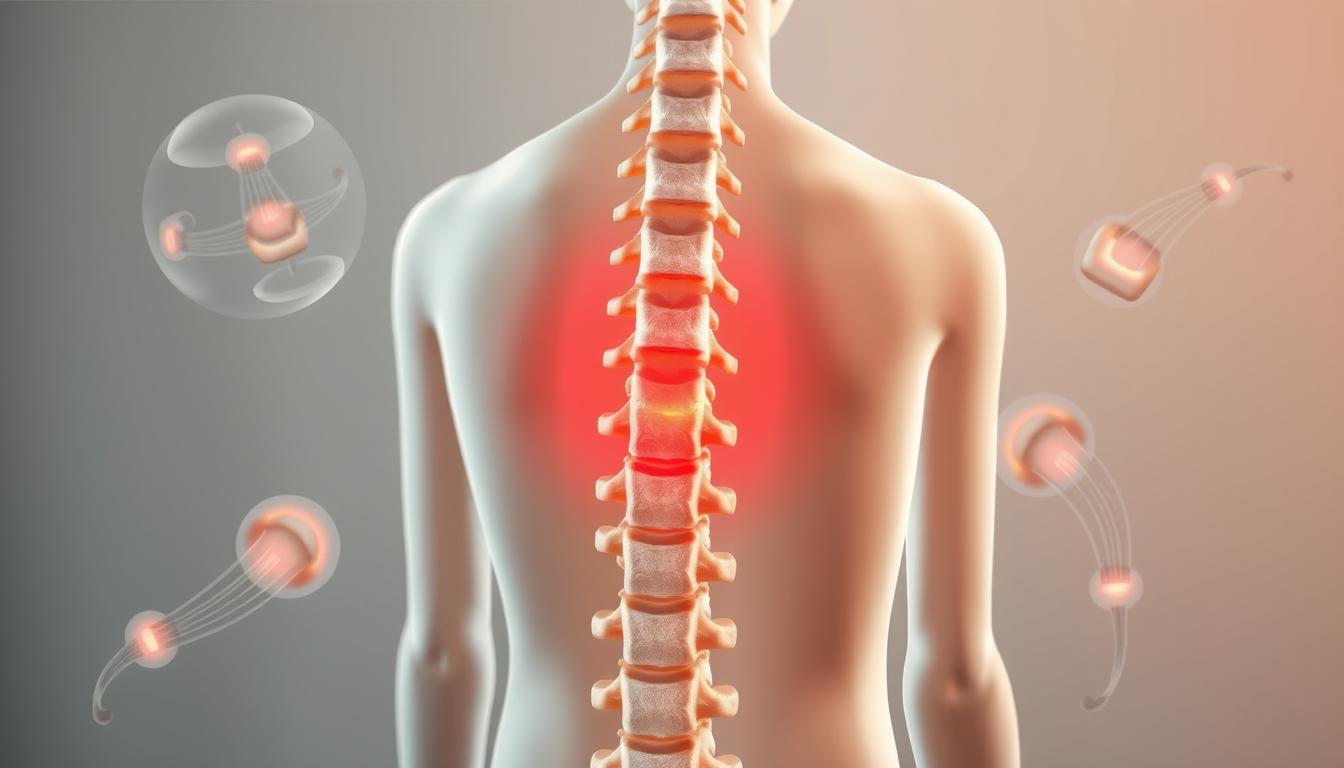Ever heard of a back pain that x-rays can’t see? That’s what non-radiographic axial spondyloarthritis (nr-axSpA) is all about. It’s a condition that’s often missed and not well understood. But what is it, and how does it differ from ankylosing spondylitis (AS)? Let’s explore the world of nr-axSpA together and learn more about it.
Key Takeaways
- Non-radiographic axial spondyloarthritis (nr-axSpA) is a chronic inflammatory condition affecting the spine and sacroiliac joints, without visible damage on x-rays.
- Unlike ankylosing spondylitis (AS), nr-axSpA is characterized by active inflammation detected through advanced imaging techniques like MRI, even before structural changes are visible.
- Differentiating between nr-axSpA and AS is crucial for proper diagnosis and tailored treatment, as the conditions fall on a disease spectrum.
- Symptoms of nr-axSpA, such as inflammatory back pain, can overlap with other musculoskeletal conditions, leading to frequent misdiagnosis and delayed treatment.
- Genetic factors, like the HLA-B27 gene, play a significant role in susceptibility to nr-axSpA, though the condition can also occur in individuals without this marker.
What is Non-Radiographic Axial Spondyloarthritis?
Non-radiographic axial spondyloarthritis (nr-axSpA) is a type of arthritis that affects the spine and sacroiliac (SI) joints. It’s different from ankylosing spondylitis (AS) because there’s no visible damage on X-rays. Yet, it shares many symptoms with AS and is seen as part of the same disease family.
Defining Non-Radiographic Axial Spondyloarthritis
Magnetic resonance imaging (MRI) has changed how we diagnose nr-axSpA. MRI scans can spot inflammation in the SI joints before X-rays can. This led to the creation of the ASAS Classification Criteria, which defined axial spondyloarthritis and its non-radiographic form. The modified New York Criteria, meanwhile, define “definitive damage” on SI joint X-rays for AS.
Distinguishing Nr-axSpA from Ankylosing Spondylitis
Nr-axSpA and AS are similar but distinct. The main difference is that nr-axSpA doesn’t show joint damage on X-rays, while AS does. About 10 to 40 percent of nr-axSpA patients will develop AS over two to 10 years.
It’s important to understand the differences between nr-axSpA and AS for accurate diagnosis and treatment. Healthline and other trusted sources provide valuable information to help patients and doctors manage this complex condition.
Symptoms and Diagnostic Process
Understanding non-radiographic axial spondyloarthritis (nr-axSpA) starts with knowing its symptoms and how doctors diagnose it. People with nr-axSpA often have chronic low back pain that starts early, before 40-45 years old. This pain gets better with activity and doesn’t go away with rest.
They might also have other symptoms like arthritis in other parts of the body, eye inflammation, psoriasis, and inflammatory bowel disease.
Common Symptoms of Nr-axSpA
Unlike ankylosing spondylitis (AS), nr-axSpA doesn’t show clear damage on x-rays of the sacroiliac (SI) joints. Doctors look for the HLA-B27 gene and MRI signs of inflammation in the SI joints to diagnose nr-axSpA. They also use tests like ESR and CRP to check for inflammation.
- Chronic low back pain starting before age 40-45
- Inflammatory back pain pattern (improved with activity, not relieved by rest)
- Peripheral inflammatory arthritis
- Iritis (eye inflammation)
- Psoriasis
- Inflammatory bowel disease
Imaging and Laboratory Tests for Diagnosis
To diagnose nr-axSpA, doctors check for the HLA-B27 gene and look at MRI scans for inflammation in the sacroiliac joints. They also use tests like ESR and CRP to see if there’s inflammation.
It’s hard to diagnose nr-axSpA because it doesn’t show up on x-rays like ankylosing spondylitis does. But, by looking at symptoms, genetic markers, and MRI scans, doctors can accurately diagnose and treat it.
non radiographic axial spondyloarthritis
Non-radiographic axial spondyloarthritis (nr-axSpA) is a type of axial spondyloarthritis (axSpA). It affects the spine and sacroiliac (SI) joints. Unlike ankylosing spondylitis (AS), nr-axSpA doesn’t show damage on x-rays.
Advanced imaging like MRI helps diagnose nr-axSpA. It finds inflammation in SI joints before x-rays can. This is crucial for early treatment.
Studies show nr-axSpA might be as common as AS. It could be just as common in women as in men. But, it’s less common in African Americans than in other races.
Thanks to MRI, diagnosing nr-axSpA has gotten better. It finds inflammation in SI joints, even without x-ray changes. Early treatment is key to avoid damage.
Symptoms of nr-axSpA and AS can be similar. But, nr-axSpA doesn’t show joint damage on x-rays. Knowing this helps doctors choose the right treatment.
Causes and Risk Factors
Role of Genetics and Immune System
The exact cause of non-radiographic axial spondyloarthritis (nr-axSpA) is still a mystery. It’s thought to be a mix of genetic and immune system issues. About 85% of those with nr-axSpA have the HLA-B27 gene, which can lead to immune problems.
Nr-axSpA is seen as a mix of autoinflammatory and autoimmune conditions. The immune system attacks healthy tissue, causing inflammation. This leads to symptoms.
In nr-axSpA, the body makes too much tumor necrosis factor (TNF). This protein fuels the inflammation and symptoms. There are also genetic links, like in interleukin-23 receptor, TAP1, TAP2, PD 1.3, PD 1.5, PD 1.9, and HLA-B27.
| Genetic Factor | Association with nr-axSpA |
|---|---|
| HLA-B27 gene | Approximately 85% of people with nr-axSpA have the HLA-B27 gene, which is often linked to problems with the immune system. |
| Interleukin-23 receptor | Genetic polymorphisms in the interleukin-23 receptor gene have been associated with nr-axSpA. |
| TAP1 and TAP2 | Genetic variations in the TAP1 and TAP2 genes, which are involved in antigen presentation, have been linked to nr-axSpA. |
| PD 1.3, PD 1.5, PD 1.9 | Polymorphisms in the PD-1 (programmed cell death 1) gene have been identified as potential genetic risk factors for nr-axSpA. |
While the HLA-B27 gene is a big risk factor, not everyone with it gets nr-axSpA. This shows other genetic and environmental factors also matter in the disease’s development.
Prevalence and Onset
Non-radiographic axial spondyloarthritis (nr-axSpA) is rare, affecting less than 1% of Americans. It usually starts before age 45. The disease affects men and women almost equally, unlike ankylosing spondylitis.
This balance in gender could make diagnosing nr-axSpA in women harder. It might lead to delays in finding out what’s wrong.
In Europe, the disease is found in 0.08% of people in France to 0.49% in Turkey. In the Americas, it’s seen in 0.60% of Mexicans and 0.90–1.40% of Americans. Also, 10% to 60% of those with nr-axSpA will get ankylosing spondylitis within 2 to 10 years.
| Region | Prevalence of Axial SpA |
|---|---|
| Europe | 0.08% (France) to 0.49% (Turkey) |
| Americas | 0.60% (Mexico), 0.90–1.40% (United States) |
The nonradiographic axial spondyloarthritis (nr-axSpA) is more common in Asia (36.46%) and less common in Africa (16.02%). Knowing the local disease patterns is key to managing nr-axSpA.

In summary, nr-axSpA is rare, affecting less than 1% of Americans. It starts in young adulthood and affects men and women equally. Knowing where and when it starts is vital for early diagnosis and treatment.
Treatment Options
Managing non-radiographic axial spondyloarthritis (nr-axSpA) requires a detailed plan. It aims to reduce pain and improve function. The goal is also to stop the disease from getting worse.
Medications for Inflammation and Pain Management
Nonsteroidal anti-inflammatory drugs (NSAIDs) are often the first choice. They help with pain and inflammation. If NSAIDs don’t work, doctors might suggest other treatments.
These could include tumor necrosis factor (TNF) inhibitors or interleukin-17 (IL-17) inhibitors. These drugs target specific inflammatory pathways. Disease-modifying antirheumatic drugs (DMARDs) are also used, especially for joint symptoms.
Physical Therapy and Lifestyle Changes
Medicine is just part of the solution. Physical therapy and lifestyle changes are also key. Regular exercise, like swimming or cycling, helps keep joints flexible and reduces pain.
Quitting smoking is also important. It can help slow down the disease’s progress. Topical treatments, like pain creams, offer relief for specific areas. Acupuncture and massage can also help some people.
Getting enough sleep and managing stress are important too. Making work adjustments can also improve life with nr-axSpA. Working together, healthcare providers, physical therapists, and patients can manage symptoms well.
Nr-axSpA in Women
Women with non-radiographic axial spondyloarthritis (nr-axSpA) often feel pain in many parts of their body. This can make it harder to get a diagnosis. On average, it takes women over a year longer than men to get a correct diagnosis.
Healthcare providers need to know how nr-axSpA affects women differently. This knowledge helps them give better care to female patients. It’s crucial for understanding and treating the condition effectively.
A study looked at how treatment works for men and women with nr-axSpA. It found that women were less likely to see a big improvement in their symptoms. Only 17% of women reached the 40% improvement mark at 1 year, compared to 38% of men.
This study shows we need to learn more about treating nr-axSpA in women. By focusing on the unique challenges women face, we can improve their care. This includes better diagnosis and treatment outcomes.
Progression and Long-Term Management
Non-radiographic axial spondyloarthritis (nr-axSpA) and ankylosing spondylitis (AS) are closely related. Not all nr-axSpA patients will develop AS. Studies suggest that 5% to 30% of nr-axSpA patients may progress to AS over 2 to 30 years.
Even without becoming AS, nr-axSpA can cause structural damage and joint fusion if untreated. It’s vital to manage nr-axSpA long-term to avoid these issues. This includes regular monitoring, a detailed treatment plan, and managing any related health problems.
- High-intensity exercise for 3 months can reduce disease activity in axial spondyloarthritis (axSpA) by 100 patients in a multicentre randomized trial.
- TNFα blockers have proven efficacy in treating both ankylosing spondylitis and non-radiographic axial spondyloarthritis, according to a meta-analysis.
- Nonsteroidal anti-inflammatory drugs (NSAIDs) can be effective for managing axial spondyloarthritis, as shown in a Cochrane review.
| Comorbidities | Impact |
|---|---|
| Ischemic heart disease | Patients with ankylosing spondylitis have an increased risk, as shown in a population-based study. |
| Cardiovascular and cerebrovascular mortality | Increased risk in patients with ankylosing spondylitis, based on a population-based study. |
Using NSAIDs regularly can help reverse inflammation’s effects on AS progression, studies show. Biologic therapies targeting interleukin-17A and interleukin-23 have also shown promise in treating axial spondyloarthritis.
Effective management of nr-axSpA requires ongoing monitoring and a comprehensive treatment plan. This should include both medication and non-medication interventions to manage the disease’s progression and long-term outcomes.
Comorbidities and Associated Conditions
People with non-radiographic axial spondyloarthritis (nr-axSpA) often face more health issues. These can include uveitis (eye inflammation), inflammatory bowel disease, and psoriasis. These extra-articular manifestations can greatly affect their health and life quality.
A study with 1,776 patients with axial spondyloarthritis (axSpA) found common health problems. These were hypertension, depression, and chronic lung diseases. The study showed a strong link between these health issues and how active the disease is, as well as how much it affects daily life.
More research is needed to find the best way to handle these health problems in nr-axSpA patients. By focusing on these issues, doctors can help improve the well-being and life quality of those with this chronic condition.
Prevalence and Impact of Comorbidities
Studies have shown that many patients with axial spondyloarthritis have other health issues. These include uveitis, inflammatory bowel disease, and psoriasis. These extra-articular manifestations can greatly affect how active the disease is, how well a person can function, and their overall health.
| Comorbidity | Prevalence in axSpA Patients | Impact on Disease Activity and Function |
|---|---|---|
| Hypertension | High | Significant association with BASFI |
| Depression | High | Significant association with BASDAI and BASFI |
| Chronic Pulmonary Disease | High | Significant association with BASDAI and BASFI |
The study’s findings highlight the need for early detection and management of these health problems. This is crucial to improve the outcomes for those with non-radiographic axial spondyloarthritis.
“The prevalence of comorbidities in patients with axial spondyloarthritis was reported to be high, with a significant association between the overall burden of comorbidities and disease activity/function in these patients.”
Living with Non-Radiographic Axial Spondyloarthritis
Living with non-radiographic axial spondyloarthritis (nr-axSpA) is tough, both physically and emotionally. People with this condition often face ups and downs, leading to uncertainty and frustration. Joining support groups and finding coping strategies can help manage the emotional side of this chronic illness.
Coping Strategies and Support Resources
Talking openly with loved ones about the daily challenges of nr-axSpA is key. Getting mental health support, like counseling or therapy, can help with the emotional toll. The Arthritis Foundation and the Spondylitis Association of America provide important resources and community support for those with nr-axSpA.
Keeping a positive outlook can help manage pain in people with nr-axSpA, showing how much the mind affects the body. Creating a support network through online groups or local meetings can also help those dealing with this chronic condition.
“Being part of the arthritis community is a great way to find resources and connect with others for support and to share information.”
Dealing with the physical symptoms of nr-axSpA might need a mix of medicines, physical therapy, and lifestyle changes. By working with healthcare providers and using coping strategies, people can learn to handle the ups and downs of this chronic condition.
| Coping Strategies | Support Resources |
|---|---|
|
|
Conclusion
Non-radiographic axial spondyloarthritis (nr-axSpA) is a chronic condition that affects many people. It’s similar to ankylosing spondylitis but doesn’t show visible joint damage on x-rays. Despite this, it can cause a lot of pain, stiffness, and disability.
Getting an early diagnosis and treatment that fits each person is key. This approach includes medicines, physical therapy, and changes in lifestyle. More research and awareness are needed to better understand and manage nr-axSpA.
Understanding nr-axSpA is an ongoing journey. We must tackle chronic inflammation, diagnose early, and offer tailored treatments. By working together, we can improve life for those with nr-axSpA. Healthcare teams, researchers, and patients can overcome the challenges of this disease together.



